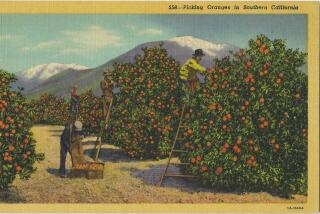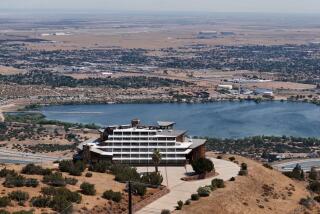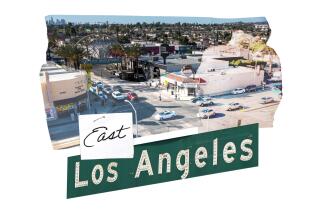It was the last of the county’s...
- Share via
It was the last of the county’s 88 cities to be incorporated (in 1991), a piece of turf steeped in historic lawlessness, an artists’ weekend getaway and the permanent retreat of pets of the rich and famous.
A sign atop a hay wagon that once marked the town entrance read: “Welcome to Calabasas, Last of the Old West.” Although the sign has been dismantled, its spirit remains.
Calabasas was a rowdy and rugged stagecoach stop along El Camino Real. Settled in the late 1850s by Miguel Leonis, a towering Basque immigrant who gained control of he land by marrying a widowed Mission Indian named Espiritu Chujilla, the 1,100 acres were named Rancho El Escorpion--the scorpion.
Leonis, soon nicknamed the “King of Calabasas,” fought off all comers with gun, guile, muscle --and court injunction. In 1889, after winning a case, he was found dead in an overturned wagon. Rumors of murder spread, but nothing was proved.
Still, rowdiness was the rule. Across from the Leonis adobe stood the Calabasas Corner Inn, a six-room store that served the town’s lusty social life and was a major stop on the stage line to Santa Barbara.
Townspeople met there to decide the fate of alleged bandits and cattle rustlers. In the 1870s, the bartender and ranchers supposedly captured three of Tiburcio Vasquez’s bandits, threw them into a well in front of the inn and dynamited it shut. More local justice was dispensed at a nearby “hanging tree,” which blew down a few years ago. The town saved the pieces for reassembly but someone ran off with the noose.
The land was not divided until after Espiritu Leonis died in 1906. The Monterey-style adobe later became a museum and anchor for Old Town.
In 1928, ground was broken for a “happier hunting ground,” the Los Angeles Pet Memorial Park. The curious still visit the graves of Humphrey Bogart’s dog Droopy and Charlie Chaplin’s cat Boots.
Calabasas’ first subdivision was a 140-acre colony called Park Moderne, an artists’ mecca in the 1930s. Frequent visitors included novelist John Steinbeck and comedian Jimmy Durante.
In 1964, supermarket developers planned to destroy the Leonis adobe, but philanthropist Kathleen Beachy purchased the site for $275,000 and turned it over to the nonprofit Leonis Adobe Assn.
The area has been called Calabasas for at least a century, after a wagonload of pumpkins overturned there. The scattered squash grew wild, and the area became known by the Spanish word for pumpkins: calabazas.
*
* A DURANTE TALE: Legend holds that when Durante’s wife was staying with friends at Park Moderne, he closed his show that night--and ever after--with this sign-off: “Good night, Mrs. Calabash, wherever you are.”
*
* REAL-LIFE HERO: In the 1970s, longtime resident and Lone Ranger Clayton Moore splashed into Lake Calabasas to rescue twin 7-year-old girls stranded on a raft. He towed them to safety and departed before he could be thanked. He did not leave a silver bullet.
(BEGIN TEXT OF INFOBOX / INFOGRAPHIC)
CALABASAS Inside Out / By the Numbers
CITY BUSINESS
Incorporated: April 5, 1991
Number of city parks: 4
City employees: 31 fulltime; 2 part time
1996-97 operating budget: $7 million (capital & restricted funds excluded)
****
ETHNIC BREAKDOWN
Latino: 4%
White: 89%
Asian: 5%
Black / Other: 1%
****
PEOPLE
Population: 18,527
Households: 7,069
Average household size: 3
Median age: 32
****
MONEY
Median household income: $66,421
Median household income / L.A. County: $34,965
Median home value: $450,000
Source: City of Calabasas, based on 1990 Census. Percentages have been rounded to the nearest whole number.
More to Read
Sign up for Essential California
The most important California stories and recommendations in your inbox every morning.
You may occasionally receive promotional content from the Los Angeles Times.










